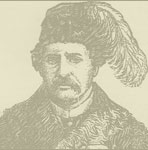

 |
Western CanadaThe search for the Northwest Passage, gateway to the Orient and its riches, motivated Europeans to explore the West1 from the North, in the early part of the 17th century. They failed to discover the route, but they did discover Aboriginal people in that territory: the Chipewyans, Amisk, Esclaves, Cris, Pieds-Noirs, Assiniboines, and Gros-Ventres. They also learned the fur trade. In 1670, Médard Chouart Des Groseillers and Pierre-Esprit Radisson persuaded England to found the Hudson’s Bay Company, giving it full control over the fur trade on the vast territory of Rupert’s Land (including, according to contemporary geography, Northern Québec, the part of Ontario north of the St. Lawrence system, all of Manitoba, most of Saskatchewan, Southern Alberta, and part of the Northwest Territories and Nunavut). For more than two hundred years, fur trade was the key activity, which favored exploration and development. Fearful of the expansionary designs of the United States on Western territories, which remained an obstacle to a prospective union with British colonies on the west coast, the Canadian government sent Sir George-Étienne Cartier and William McDougall to London in 1868 to resume negotiations undertaken in 1857 over the ownership of Rupert’s Land. The Hudson’s Bay Company finally ceded its territorial rights to the Dominion of Canada, and the transfer of territory was set for December 1, 1869. Angered at not being consulted about the change of jurisdiction, the Métis, with Louis Riel as their leader, formed a provisional government in protest and jailed a few Canadian partisans of the annexation. The conflict ended, but the government never lived up to its promise of amnesty. Louis Riel and other Métis were then forced into exile. In 1885, a second rebellion led by Louis Riel, who had returned from the United States, along with Métis and natives, was crushed by Canadian troops. Louis Riel was later executed. The Canadian government finally took possession of Rupert’s Land in 1870 and, though willing to recognize it as a territory, it created that same year the province of Manitoba, in response to the claims of Métis. The government retained Crown lands and the development of natural resources. The remaining territory constitutes the Northwest territories. The following year, British Columbia, made up of the island of Vancouver and inlands of the province since 1866, joined Confederation, subject to the condition that the transcontinental railway reached the coast. In the last part of the 19th century, a major immigration program was set up by Ottawa to populate the West. From 1896 to World War I, there was an influx of immigrants from Canada, the United States, Great Britain, and Continental Europe. In 1905, the federal government created the provinces of Alberta and Saskatchewan from part of the Northwest Territories. It again retained Crown lands, which were eventually transferred to the Prairie Provinces in 1930. | ||||||||||
| Français |
Credits |
||